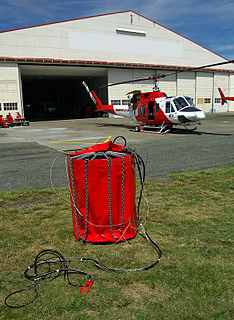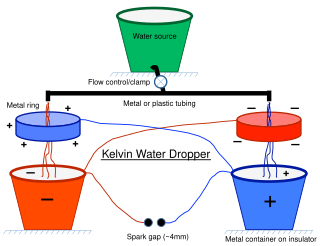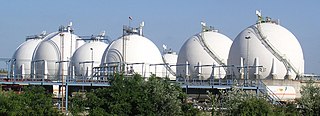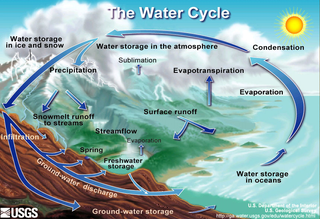A rotating tank is a device used for fluid dynamics experiments. Typically cylinders filled with water on a rotating platform, the tanks can be used in various ways to simulate the atmosphere or ocean.
For example, a rotating tank with an ice bucket in the center can represent the Earth, with a cold pole simulated by the ice bucket. Just as in the atmosphere, eddies and a westerly jetstream form in the water.
Isaac Newton's rotating bucket argument was designed to demonstrate that true rotational motion cannot be defined as the relative rotation of the body with respect to the immediately surrounding bodies. It is one of five arguments from the "properties, causes, and effects" of "true motion and rest" that support his contention that, in general, true motion and rest cannot be defined as special instances of motion or rest relative to other bodies, but instead can be defined only by reference to absolute space. Alternatively, these experiments provide an operational definition of what is meant by "absolute rotation", and do not pretend to address the question of "rotation relative to what?" General relativity dispenses with absolute space and with physics whose cause is external to the system, with the concept of geodesics of spacetime.
A barometer is a scientific instrument that is used to measure air pressure in a certain environment. Pressure tendency can forecast short term changes in the weather. Many measurements of air pressure are used within surface weather analysis to help find surface troughs, pressure systems and frontal boundaries.

Dry ice is the solid form of carbon dioxide. It is used primarily as a cooling agent, but is also used in fog machines at theatres for dramatic effects. Its advantages include lower temperature than that of water ice and not leaving any residue. It is useful for preserving frozen foods where mechanical cooling is unavailable.

A rain gauge is an instrument used by meteorologists and hydrologists to gather and measure the amount of liquid precipitation over an area in a predefined area, period of time. It is used for determining the depth of precipitation that occurs over a unit area and thus measuring rainfall amount.

A fire engine is a road vehicle that functions as a firefighting apparatus. The primary purposes of a fire engine include transporting firefighters and water to an incident as well as carrying equipment for firefighting operations. Some fire engines have specialized functions, such as wildfire suppression and aircraft rescue and firefighting, and may also carry equipment for technical rescue.
In theoretical physics, particularly in discussions of gravitation theories, Mach's principle is the name given by Einstein to an imprecise hypothesis often credited to the physicist and philosopher Ernst Mach. The purpose of the hypothesis was to attempt to explain how rotating objects maintain a frame of reference, such as gyroscopes and spinning celestial bodies. The idea is that the existence of absolute rotation is determined by the large-scale distribution of matter, as exemplified by this anecdote:
You are standing in a field looking at the stars. Your arms are resting freely at your side, and you see that the distant stars are not moving. Now start spinning. The stars are whirling around you and your arms are pulled away from your body. Why should your arms be pulled away when the stars are whirling? Why should they be dangling freely when the stars don't move?

A halo is an optical phenomenon produced by light interacting with ice crystals suspended in the atmosphere. Halos can have many forms, ranging from colored or white rings to arcs and spots in the sky. Many of these appear near the Sun or Moon, but others occur elsewhere or even in the opposite part of the sky. Among the best known halo types are the circular halo, light pillars, and sun dogs, but many others occur; some are fairly common while others are (extremely) rare.

The Antarctic Muon And Neutrino Detector Array (AMANDA) is a neutrino telescope located beneath the Amundsen–Scott South Pole Station. In 2005, after nine years of operation, AMANDA officially became part of its successor project, the IceCube Neutrino Observatory.

European Remote Sensing satellite (ERS) was the European Space Agency's first Earth-observing satellite programme using a polar orbit. It consisted of 2 satellites, ERS-1 and ERS-2.

A helicopter bucket is a specialised bucket suspended on a cable carried by a helicopter to deliver water for aerial firefighting. Each bucket has a release valve on the bottom which is controlled by the helicopter crew. When the helicopter is in position, the crew releases the water to extinguish or suppress the fire below. Each release of the water is referred to as a drop. The design of the buckets allows the helicopter to hover over a water source – such as a lake, river, pond, or tank – and lower the bucket into the water to refill it. This allows the helicopter crew to operate the bucket in remote locations without the need to return to a permanent operating base, reducing the time between successive drops.

The Kelvin water dropper, invented by Scottish scientist William Thomson in 1867, is a type of electrostatic generator. Kelvin referred to the device as his water-dropping condenser. The apparatus is variously called the Kelvin hydroelectric generator, the Kelvin electrostatic generator, or Lord Kelvin's thunderstorm. The device uses falling water to generate voltage differences by electrostatic induction occurring between interconnected, oppositely charged systems. This eventually leads to an electric arc discharging in the form of a spark. It is used in physics education to demonstrate the principles of electrostatics.

The Ekman layer is the layer in a fluid where there is a force balance between pressure gradient force, Coriolis force and turbulent drag. It was first described by Vagn Walfrid Ekman. Ekman layers occur both in the atmosphere and in the ocean.

Storage tanks are containers that hold liquids, compressed gases or mediums used for the short- or long-term storage of heat or cold. The term can be used for reservoirs, and for manufactured containers. The usage of the word tank for reservoirs is uncommon in American English but is moderately common in British English. In other countries, the term tends to refer only to artificial containers.
The physicist Sir Isaac Newton first developed this idea to get rough approximations for the impact depth for projectiles traveling at high velocities.

A trickling filter is a type of wastewater treatment system. It consists of a fixed bed of rocks, coke, gravel, slag, polyurethane foam, sphagnum peat moss, ceramic, or plastic media over which sewage or other wastewater flows downward and causes a layer of microbial slime (biofilm) to grow, covering the bed of media. Aerobic conditions are maintained by splashing, diffusion, and either by forced-air flowing through the bed or natural convection of air if the filter medium is porous. The treatment of sewage or other wastewater with trickling filters is among the oldest and most well characterized treatment technologies.

The Global Energy and Water Exchanges project is an international research project and a core project of the World Climate Research Programme (WCRP).

The Hornsby Water Clock, titled Man, Time and the Environment is a piece of kinetic sculpture, a decorative fountain and a functional clock in the Florence Street pedestrian mall in Hornsby, New South Wales, Australia. Unveiled in 1993, the sculpture was designed and engineered by Victor Cusack and constructed of bronze, stainless steel and glass by Victor and his foundry floor manager Rex Feakes. Construction, including alterations to the mall, cost over A$1 million and took two and half years; thereafter, chicken bones and other carelessly discarded items caused many breakdowns before the water filtration system was upgraded.

In physics, the concept of absolute rotation—rotation independent of any external reference—is a topic of debate about relativity, cosmology, and the nature of physical laws.

A floor scrubber is a floor cleaning device. It can be a simple tool such as a floor mop or floor brush, or in the form of a walk-behind or a ride-on machine to clean larger areas by injecting water with cleaning solution, scrubbing, and lifting the residue off the floor. With advancements in robotics, autonomous floor-scrubbing robots are available as well.

The Ice Bucket Challenge, sometimes called the ALS Ice Bucket Challenge, was an activity involving the pouring of a bucket of ice water over a person's head, either by another person or self-administered, to promote awareness of the disease amyotrophic lateral sclerosis and encourage donations to research. The challenge was co-founded by Pat Quinn and Pete Frates; it went viral on social media during July–August 2014. In the United States, many people participated for the ALS Association, and in the United Kingdom, many people participated for the Motor Neurone Disease Association, although some individuals opted to donate their money from the Ice Bucket Challenge to other organizations.